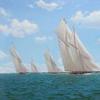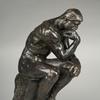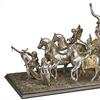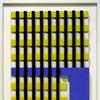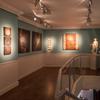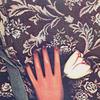The Neo-Victorians: Contemporary Artists Revive Gilded-Age Glamour in Exhibition at Hudson River Museum
- YONKERS, New York
- /
- February 05, 2018
The Neo-Victorians: Contemporary Artists Revive Gilded-Age Glamour, on view at the Hudson River Museum from February 10 through May 13, 2018, explores a resurgence of interest over the last decade in ornamental lushness, with works of art that conceal pointed social commentary beneath seductive surface techniques. More than 20 contemporary artists whose work is inspired by the aesthetics of the 19th century have shaped, molded, and transformed these ideas to reflect today’s concerns, commenting on gender roles and societal tensions under the guise of the overt beauty. The Neo-Victorians will encourage audiences both familiar and unfamiliar with the Gilded Age to look at the growing group of contemporary artists imbued with a “Victorian aesthetic,” and to recognize how visual influences of the past continue to shape art in the present day. This topic is of particular interest and relevance to the mission of the Hudson River Museum as our collection includes American Art from the 19th century to today as well as Glenview, a Gilded Age home on the National Register of Historic Places, considered one of the finest Eastlake interiors open to the public.
The artists conjure a staggering array of possible approaches to the subject matter, using a wide variety of media, including large-scale installations, textiles, cut-paper sculptures, video, photography, and more. Artists include Troy Abbott, Jennifer Angus, Joan Bankemper, Nancy Blum, Ebony Bolt, Laurent Chehere, Alison Collins, Camille Eskell, Lisa A. Frank, Kirsten Hassenfeld, Dan Hillier, Marilyn Holsing, Patrick Jacobs, Pat Lasch, Catherine Latson, Zachari Logan, Davy and Kristen McGuire, Chet Morrison, Donna Sharrett, Deborah Simon, Nick Simpson, and Darren Waterston.
The exhibition, guest curated by Bartholomew F. Bland, Executive Director of the Lehman College Art Gallery, City University of New York, is presented in three broad thematic groupings:
Artist as Naturalist, exploring the ways that artists mine the natural world for inspiration;
Artist as Purveyor of the Fantastical, referencing a Victorian obsession with bizarre subject matter, and following the “steampunk” tradition of merging science fiction and fantastic technology;
Artist as Explorer of Domesticity, satirizing the “cult of domesticity,” the idea of feminine middle-class women at the center of the home.
Bland comments on the relevance of these themes today: “The issues of contested domesticity and the concurrent feminism that runs just under the surface of many of these highly decorated pieces are urgent ones that remain just as hotly contested as they were more than a century ago. The broad societal interest in technology has led to a counter-movement that emphasizes individual, bespoke creativity in an increasingly mass-producing, mass-consuming society. Likewise, the embrace, exploration, and appreciation of the natural world’s beauty is an eternal source of inspiration for artists.”
There is no coherent “Neo-Victorian” movement, no manifesto or single guiding principle subscribed to by each of these artists. Yet, they reject the notion of industrial mass production, instead visibly emphasizing and reveling in elaborate construction, a surfeit of detailed design, and a visceral appeal to the senses. Spiral, 2017, a “peephole” installation by Patrick Jacobs features an enchanted landscape that will be built into the gallery walls; a multimedia, cut-paper diorama by Marilyn Holsing, The Pursuit of Love, incorporates video and sound; and Catherine Latson’s Birch Corset, 2016, a triumph of expanding and contracting S-curves and fluidity, pushes the flexibility of wood to its extreme. Jennifer Angus is creating an elaborate, site-specific installation throughout the Great Hall of Glenview, consisting of preserved insects affixed in geometrical patterns, referencing the Victorian interest in specimen collecting and the intense desire to create order through formal classification. Works on paper, such as Trumpet and Passion, 2012, by Nancy Blum depict floral motifs drawn from nature but also gather inspiration from 19th-century designer William Morris. Other examples take on a fantastical effect, rooted in the work of novelist Jules Verne or reflecting the Victorian tradition of merging human portraiture with animal parts.
HRM Teaching Artist-in-Residence
Ebony Bolt, who is producing a new work for this exhibition, creates visually positive drawings and prints to combat the crippling nature of the human condition. Her intent is to highlight the importance of diversity by illustrating her subjects, including commuters on the train, using the fewest lines possible. Bolt will also be the HRM Teaching Artist-in-Residence during the run of the exhibition. Her goal throughout her residency is to explore the ways in which intersectionality influences the design process. She challenges the audience to create prints that proudly illustrate their inner being.
Probe the art, science, film and culture of the exhibition through an exciting program roster.



